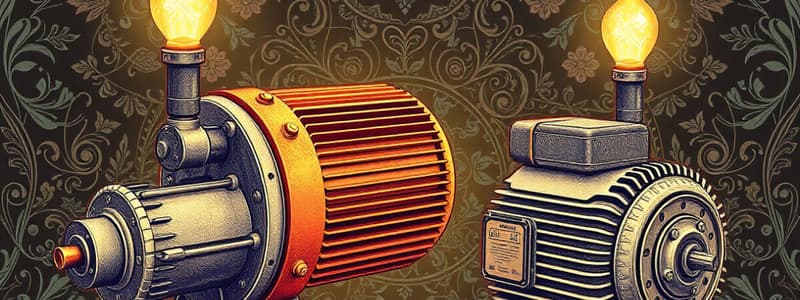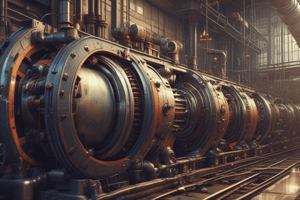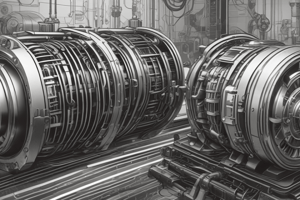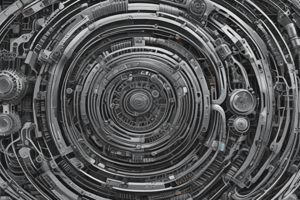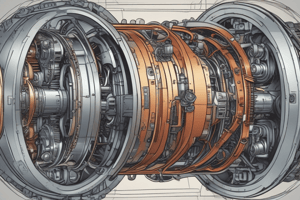Podcast
Questions and Answers
What is the primary advantage of using a three-phase transformer over a single-phase transformer?
What is the primary advantage of using a three-phase transformer over a single-phase transformer?
Three-phase transformers are more efficient and cost-effective for transferring large amounts of power, making them superior in high-powered current applications.
Explain the concept of phase shift in three-phase transformers and its significance in design.
Explain the concept of phase shift in three-phase transformers and its significance in design.
Phase shift refers to the relative timing differences between the three phases, which is crucial for ensuring proper load balancing and system stability in transformer designs.
Identify and describe one type of special purpose transformer and its application.
Identify and describe one type of special purpose transformer and its application.
Isolation transformers are designed to separate different parts of a circuit for safety and noise reduction, commonly used in audio and medical equipment.
What are the different configurations available for three-phase transformers, and why are they important?
What are the different configurations available for three-phase transformers, and why are they important?
Describe the role of a current transformer in electrical systems.
Describe the role of a current transformer in electrical systems.
What are the two main categories of electrical motors?
What are the two main categories of electrical motors?
How does the direction of rotation in a DC motor get determined?
How does the direction of rotation in a DC motor get determined?
What role does the ferromagnetic core play in a single-phase transformer?
What role does the ferromagnetic core play in a single-phase transformer?
What is a key characteristic of series DC motors?
What is a key characteristic of series DC motors?
What distinguishes synchronous motors from other types of AC motors?
What distinguishes synchronous motors from other types of AC motors?
What is the primary function of a DC generator?
What is the primary function of a DC generator?
Why are single-phase transformers favored for residential applications?
Why are single-phase transformers favored for residential applications?
What determines the speed of a DC motor?
What determines the speed of a DC motor?
Flashcards
Three-phase transformer
Three-phase transformer
A transformer with three sets of windings (primary and secondary) to handle three phases simultaneously.
Single-phase transformer
Single-phase transformer
A transformer with one primary and one secondary coil.
Special purpose transformer
Special purpose transformer
Transformer tailored for unique applications beyond voltage transformation.
Phase shift
Phase shift
Signup and view all the flashcards
Instrument transformer
Instrument transformer
Signup and view all the flashcards
Electrical Motor
Electrical Motor
Signup and view all the flashcards
AC Motor
AC Motor
Signup and view all the flashcards
DC Motor
DC Motor
Signup and view all the flashcards
DC Machine
DC Machine
Signup and view all the flashcards
Transformer
Transformer
Signup and view all the flashcards
Motor Selection
Motor Selection
Signup and view all the flashcards
Electromagnetic Induction
Electromagnetic Induction
Signup and view all the flashcards
Study Notes
Introduction to Electrical Motors
- Electrical motors convert electrical energy into mechanical energy.
- They are categorized based on their type of current: AC (alternating current) motors and DC (direct current) motors.
- AC motors are further categorized into various types, including induction motors, synchronous motors, and stepper motors.
- DC motors also have several types including series motors, shunt motors, and compound motors.
- Motor selection depends on the specific application, considering factors like power requirements, speed control needs, and environmental conditions.
- Understanding motor principles is essential for effective design, operation, and maintenance.
- Typical applications for motors include industrial machinery, household appliances, and transportation systems.
DC Machines
- DC machines are used to convert electrical energy to mechanical energy and vice versa.
- They have a rotating armature and stationary field windings.
- DC machines work based on the principle of interaction between a magnetic field and a current-carrying conductor.
- The direction of rotation of the motor is determined by the direction of current in the armature and the magnetic field.
- DC generators convert mechanical energy into electrical energy by producing a current determined by the strength of the magnetic field.
- DC motors can generate different speeds depending on the design of the motor, field strength, and load.
- Types of DC machines include shunt, series, compound, and separately excited machines. Each type has distinct characteristics relating to its application.
- Key features of DC machines include their ability to control speed, their torque characteristics, and their efficiency.
Single-Phase Transformer
- A single-phase transformer is an electrical device that transfers electrical energy between two or more circuits through electromagnetic induction, usually with a single alternating current.
- It consists of two or more windings wound around a common ferromagnetic core.
- The AC current in the primary winding produces a varying magnetic field in the core.
- This induces a voltage in the secondary winding, thereby transferring energy.
- Key benefits of using single-phase transformers include their lower cost and simplicity compared to three-phase transformers.
- They are commonly used in residential and small-scale industrial settings for purposes such as voltage transformation.
- A single-phase transformer has one primary and one secondary coil.
Three-Phase Transformer
- A three-phase transformer uses three sets of windings (primary and secondary) to handle the three phases simultaneously.
- It is a more efficient and cost-effective solution for transferring large amounts of power.
- It is commonly used in industrial applications, power transmission, and distribution systems.
- Three-phase transformers are superior to single-phase transformers in situations necessitating the transfer of high-powered currents.
- A key concept is the phase shift among the phases, which requires careful consideration in design.
- Three-phase transformers come in various configurations, including delta-wye, wye-delta, and delta-delta, each having different advantages.
Special Purpose Transformers
- Special purpose transformers are designed for unique applications beyond standard voltage transformation.
- Examples include audio transformers, instrument transformers (current and potential), pulse transformers, and isolation transformers.
- These specialized transformers are tailored to serve particular needs in specific electrical setups and devices that require unique properties in the magnetic field strength, frequency of signals, and winding designs.
- These transformers are designed with particular specifications depending their intended use.
- These applications include signal processing, instrumentation, and specialized power requirements.
Studying That Suits You
Use AI to generate personalized quizzes and flashcards to suit your learning preferences.
